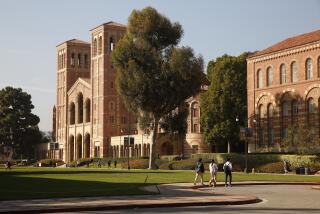Elmer Ray Noble; Zoologist Helped Start Growth of UC Santa Barbara
- Share via
Elmer Ray Noble, a protozoologist who helped develop UC Santa Barbara and became the namesake of the school’s biological sciences building, has died at the age of 92.
Noble died Thursday of pneumonia in Santa Barbara, university officials said.
Working on the Santa Barbara campus during the growth years from the school’s founding in 1944 until his retirement in 1972, Noble taught zoology but was also a key administrator during the addition of graduate programs.
“Professor Noble played an important role in the growth of this campus, particularly in graduate education,” said UC Santa Barbara Chancellor Henry T. Yang. “His contributions also included important and internationally recognized work in his field of zoology.”
The educator was the first chairman of the campus’ department of biological sciences, from 1947 to 1951--prompting the naming of the building housing those studies Elmer Ray Noble Hall in 1978.
Noble served as dean of the division of letters and science from 1951 to 1958 and vice chancellor for graduate affairs from 1959 to 1961. He was also acting provost, the chief campus officer, from 1956 to 1959.
Also a dedicated researcher, Noble focused on parasitic protozoa and particularly the study of parasites in deep-sea fish.
Born in Seoul, Korea, to American missionary parents, he discovered “a great culture shock,” according to his daughter Carolyn Cogan, when he came to the United States to attend UC Berkeley, where the change was so marked, she said, that although he went on to earn bachelor’s, master’s and doctoral degrees, he was on academic probation his freshman year.
In addition to Cogan, Noble is survived by his identical twin, Glenn; son, David; daughters Elaine Schott and Ellen McKaskle; seven grandchildren; and seven great-grandchildren.
A memorial gathering is planned for 4 p.m. March 24 at McVeagh House on the grounds of the Santa Barbara Museum of Natural History.
More to Read
Sign up for Essential California
The most important California stories and recommendations in your inbox every morning.
You may occasionally receive promotional content from the Los Angeles Times.













